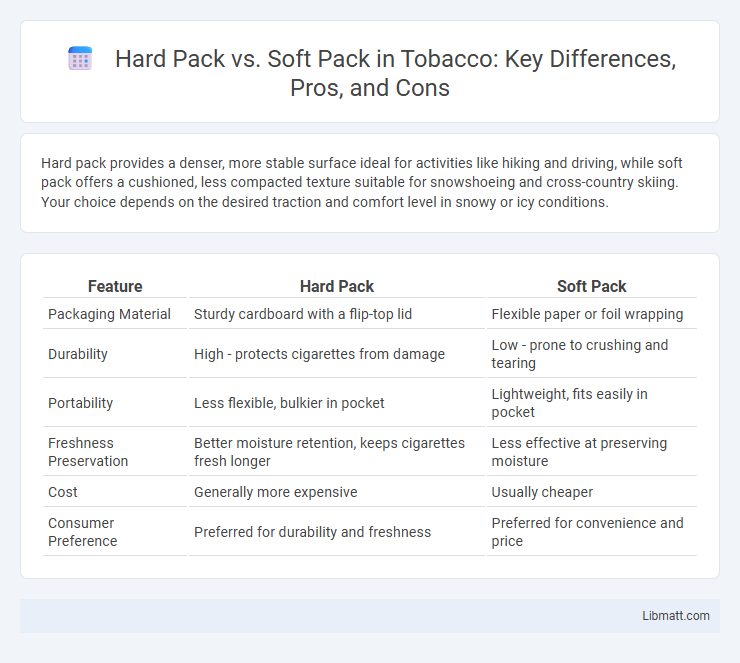Hard pack provides a denser, more stable surface ideal for activities like hiking and driving, while soft pack offers a cushioned, less compacted texture suitable for snowshoeing and cross-country skiing. Your choice depends on the desired traction and comfort level in snowy or icy conditions.
Table of Comparison
| Feature | Hard Pack | Soft Pack |
|---|---|---|
| Packaging Material | Sturdy cardboard with a flip-top lid | Flexible paper or foil wrapping |
| Durability | High - protects cigarettes from damage | Low - prone to crushing and tearing |
| Portability | Less flexible, bulkier in pocket | Lightweight, fits easily in pocket |
| Freshness Preservation | Better moisture retention, keeps cigarettes fresh longer | Less effective at preserving moisture |
| Cost | Generally more expensive | Usually cheaper |
| Consumer Preference | Preferred for durability and freshness | Preferred for convenience and price |
Introduction to Hard Pack vs Soft Pack
Hard pack and soft pack refer to types of compressed snow commonly encountered in winter sports and outdoor activities. Hard pack snow is densely packed and offers a firm, icy surface ideal for skiing or snowboarding stability, while soft pack snow is loosely packed, providing a fluffy, powdery texture that enhances cushioning and ease of movement. Understanding the differences between hard pack and soft pack can help you choose the best conditions for your snow activities and safety.
What is a Hard Pack?
A hard pack refers to compacted, dense snow or soil that is firm underfoot, commonly found in outdoor environments like ski slopes or trails. It provides a stable surface that supports weight without sinking, making it ideal for activities requiring solid footing. Hard pack conditions often occur after repeated compression or freezing, enhancing durability and traction.
What is a Soft Pack?
A soft pack refers to a flexible, lightweight packaging option commonly used for cigarettes, offering easier portability and a less rigid structure compared to hard packs. Unlike hard packs, soft packs are made from laminated paper or thin plastic that conforms to the shape of the contents, providing a more compact and squeezable experience. You may prefer a soft pack for its convenience and ability to fit easily into pockets without the bulk of a hard pack.
Key Differences Between Hard Pack and Soft Pack
Hard pack snow features tightly compressed, dense layers offering firm traction and stability, ideal for activities like skiing and snowmobiling. Soft pack snow consists of looser, less compacted snow crystals providing a cushioned, powdery surface preferred for snowboarding and snowshoeing. The primary differences lie in texture, density, and the resulting impact on grip, speed, and maneuverability across winter sports.
Durability and Protection: Hard Pack vs Soft Pack
Hard pack products offer superior durability and protection due to their rigid outer shell, which resists impact, abrasion, and harsh environmental conditions, making them ideal for heavy-duty use. Soft pack items provide more flexibility and lighter weight but generally have lower resistance to punctures and wear, reducing overall protection in demanding situations. Selecting between hard pack and soft pack depends on the need for toughness versus portability in various applications.
Portability and Convenience
Hard pack cases offer superior protection and easy stackability but tend to be bulkier and heavier, making them less ideal for on-the-go portability. Soft pack options, crafted from lightweight fabrics, provide flexibility and compactness, enhancing ease of transport and quick access. Travelers and commuters often prefer soft packs due to their ability to conform to tight spaces and reduce carry weight without sacrificing convenience.
Packaging Impact on Freshness
Hard pack containers provide a sturdy barrier that helps preserve freshness by minimizing oxygen exposure, which slows down spoilage and maintains product quality longer. Soft pack packaging, while flexible and lightweight, offers less protection against air and moisture, potentially reducing shelf life and freshness retention. Choosing the right packaging impacts your product's durability and how well it maintains freshness over time.
Environmental Considerations
Hard pack and soft pack cigarette packaging differ significantly in environmental impact. Hard pack boxes, typically made from rigid cardboard with metal hinges, are less recyclable due to mixed materials, while soft packs use flexible plastic and foil layers that contribute to microplastic pollution. Choosing your packaging with environmental considerations helps reduce waste and supports sustainable consumption practices.
Consumer Preferences and Market Trends
Consumer preferences for hard pack versus soft pack tobacco products vary based on factors such as portability, protection, and environmental concerns. Hard packs offer durability and better protection, appealing to users who prioritize maintaining freshness and convenience, while soft packs attract those preferring flexibility and lower price points. Market trends indicate a growing demand for sustainable packaging, influencing manufacturers to innovate in both hard and soft pack designs to align with evolving consumer values.
Which Pack is Better: Final Verdict
Hard pack offers enhanced durability and protection, making it ideal for rugged environments and long-term use, while soft pack excels in flexibility and lightweight convenience for easy transport and quick access. Your choice depends on specific needs; hard pack suits heavy-duty activities, whereas soft pack is better for casual or short-term use. Evaluating your intended application ensures the best pack type for comfort and functionality.
Hard pack vs soft pack Infographic

 libmatt.com
libmatt.com